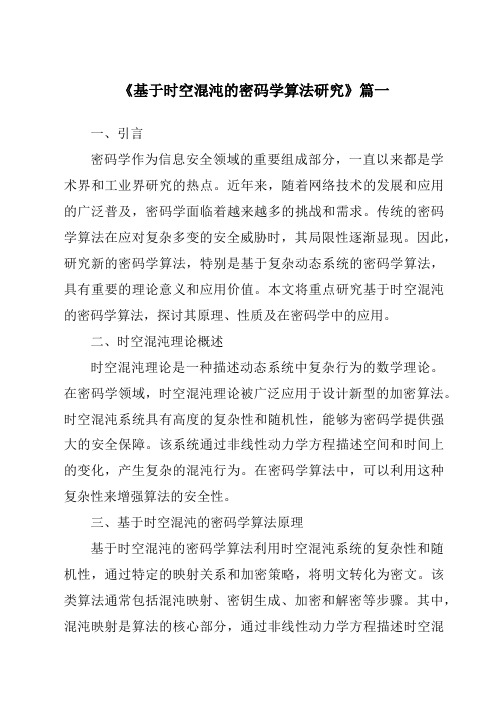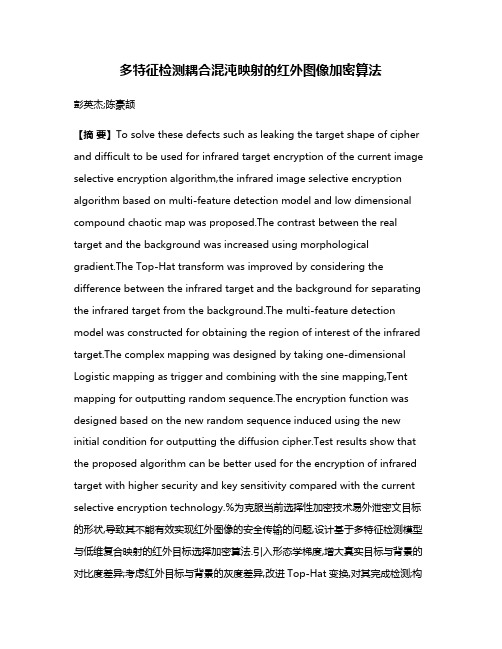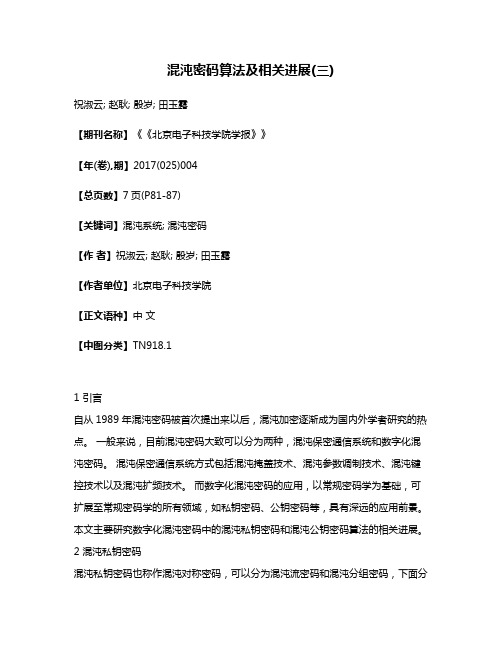基于增强型检索机制Baptista混沌的物联网加密技术研究
基于混沌的图像加密算法研究

基于混沌的图像加密算法研究图像加密算法是信息安全领域中的重要研究方向之一,它通过对图像进行加密和解密操作,实现保护图像隐私和安全传输等目的。
本文将重点探讨基于混沌的图像加密算法的研究,分析其原理、优势和应用场景。
首先,我们来了解一下混沌理论。
混沌理论是一种非线性动力学系统的研究分支,其在计算机科学和密码学领域有着广泛的应用。
混沌系统具有随机性、不可预测性和灵敏性等特点,这使得混沌可作为图像加密算法的基础。
基于混沌的图像加密算法主要包括两个部分,即混沌映射和置乱操作。
混沌映射是将图像像素映射到一个混沌的迭代序列上,而置乱操作则通过对混沌序列进行重新排列实现对图像的置乱加密。
下面我们将详细介绍这两个部分。
首先是混沌映射。
混沌映射通常选取经典的混沌系统,如Logistic映射和Henon映射等作为基础。
这些映射具有高度的不可预测性和混沌性质,适用于图像加密。
在加密过程中,首先将图像像素值归一化到[0,1]的范围内,然后通过混沌映射将像素值映射到一个混沌序列上。
通过迭代映射操作,可以得到一个与原图像无关的混沌序列。
这个序列将作为后续置乱操作的密钥,确保了加密的随机性和安全性。
接下来是置乱操作。
在加密过程中,通过对混沌序列进行重新排列,实现对图像像素的混乱置乱。
最常用的方法是基于Arnold置乱算法和Baker映射置乱算法。
Arnold置乱算法是一种二维置乱算法,通过对图像像素的行列位置进行迭代映射操作,实现像素位置的混乱。
而Baker映射置乱算法则是通过对图像像素进行乘积操作,实现图像像素值的混乱。
这两种置乱算法具有较高的随机性和不可逆性,能够有效地保障图像的安全性。
基于混沌的图像加密算法具有以下优势:第一,混沌映射和置乱操作具有高度的随机性和不可线性特征,使得加密过程中产生的密钥和置乱后的图像难以被破解和恢复。
这大大增强了图像的安全性。
第二,基于混沌的图像加密算法具有较好的抗攻击性。
混沌系统的不可预测性和随机性能够防止统计分析和密码分析等攻击手段。
《2024年基于时空混沌的密码学算法研究》范文

《基于时空混沌的密码学算法研究》篇一一、引言密码学作为信息安全领域的重要组成部分,一直以来都是学术界和工业界研究的热点。
近年来,随着网络技术的发展和应用的广泛普及,密码学面临着越来越多的挑战和需求。
传统的密码学算法在应对复杂多变的安全威胁时,其局限性逐渐显现。
因此,研究新的密码学算法,特别是基于复杂动态系统的密码学算法,具有重要的理论意义和应用价值。
本文将重点研究基于时空混沌的密码学算法,探讨其原理、性质及在密码学中的应用。
二、时空混沌理论概述时空混沌理论是一种描述动态系统中复杂行为的数学理论。
在密码学领域,时空混沌理论被广泛应用于设计新型的加密算法。
时空混沌系统具有高度的复杂性和随机性,能够为密码学提供强大的安全保障。
该系统通过非线性动力学方程描述空间和时间上的变化,产生复杂的混沌行为。
在密码学算法中,可以利用这种复杂性来增强算法的安全性。
三、基于时空混沌的密码学算法原理基于时空混沌的密码学算法利用时空混沌系统的复杂性和随机性,通过特定的映射关系和加密策略,将明文转化为密文。
该类算法通常包括混沌映射、密钥生成、加密和解密等步骤。
其中,混沌映射是算法的核心部分,通过非线性动力学方程描述时空混沌系统的行为。
密钥生成则是根据混沌映射产生的序列生成加密密钥。
在加密过程中,明文经过密钥的映射和变换,转化为密文;在解密过程中,密文通过反向的映射和变换,还原为明文。
四、基于时空混沌的密码学算法性质基于时空混沌的密码学算法具有以下性质:1. 高度复杂性:算法利用时空混沌系统的复杂性,使得加密过程具有高度的复杂性,难以被破解。
2. 随机性:算法中的混沌映射产生的序列具有随机性,保证了密钥的空间复杂性和难以预测性。
3. 抗攻击性:由于算法的高度复杂性和随机性,使得攻击者难以通过暴力破解或数学分析等方式获取明文信息。
4. 灵活性:算法可以根据具体的应用场景和需求进行定制和优化,具有较强的灵活性。
五、基于时空混沌的密码学算法应用基于时空混沌的密码学算法在信息安全领域具有广泛的应用。
多特征检测耦合混沌映射的红外图像加密算法

多特征检测耦合混沌映射的红外图像加密算法彭英杰;陈豪颉【摘要】To solve these defects such as leaking the target shape of cipher and difficult to be used for infrared target encryption of the current image selective encryption algorithm,the infrared image selective encryption algorithm based on multi-feature detection model and low dimensional compound chaotic map was proposed.The contrast between the real target and the background was increased using morphological gradient.The Top-Hat transform was improved by considering the difference between the infrared target and the background for separating the infrared target from the background.The multi-feature detection model was constructed for obtaining the region of interest of the infrared target.The complex mapping was designed by taking one-dimensional Logistic mapping as trigger and combining with the sine mapping,Tent mapping for outputting random sequence.The encryption function was designed based on the new random sequence induced using the new initial condition for outputting the diffusion cipher.Test results show that the proposed algorithm can be better used for the encryption of infrared target with higher security and key sensitivity compared with the current selective encryption technology.%为克服当前选择性加密技术易外泄密文目标的形状,导致其不能有效实现红外图像的安全传输的问题,设计基于多特征检测模型与低维复合映射的红外目标选择加密算法.引入形态学梯度,增大真实目标与背景的对比度差异;考虑红外目标与背景的灰度差异,改进Top-Hat变换,对其完成检测;构建多特征检测模型,获取包含红外目标的感兴趣区域;将一雏Logistic映射作为触发器,联合sine映射、Tent映射,设计复合映射,改变感兴趣区域内的像素位置;改变复合映射的初值,输出新的混沌数组,设计加密函数,输出扩散密文.测试结果表明,与当前选择性加密技术相比,该算法能够更好地用于红外目标的加密,且其安全性更高.【期刊名称】《计算机工程与设计》【年(卷),期】2017(038)011【总页数】7页(P3099-3105)【关键词】红外图像;选择性加密;低维复合映射;Top-Hat变换;多特征检测模型;感兴趣区域;形态学梯度【作者】彭英杰;陈豪颉【作者单位】青海民族大学计算机学院,青海西宁810007;兰州理工大学计算机与通信学院,甘肃兰州730050【正文语种】中文【中图分类】TP391.4传统的数据保密技术没有考虑图像的大数据容量与高的冗余度等特性,导致其难以确保加密图像进行安全传输[1-5]。
基于混沌神经网络加密研究

基于混沌神经网络加密研究混沌神经网络加密是一种新兴的加密算法,它结合了混沌系统和神经网络的优势,具有高度的安全性和可靠性。
在这篇文章中,我们将详细介绍混沌神经网络加密的原理、特点和应用。
混沌神经网络加密的原理是基于混沌系统的非线性和随机性特征以及神经网络的非线性映射能力。
混沌系统是一种高度不可预测的系统,具有随机性、非线性和灵敏性等特点,这使得混沌神经网络加密具有高度的安全性。
神经网络是一种仿生学的模式识别和数据处理工具,它可以通过学习和训练来适应不同的数据模式,具有自适应性和学习能力。
混沌神经网络加密的加密过程分为训练和加密两个阶段。
首先,在训练阶段,将混沌系统的初始条件作为训练样本输入到神经网络中,通过反向传播算法调整神经网络的权重和阈值。
然后,在加密阶段,将待加密的原始数据输入到训练好的神经网络中,通过神经网络的非线性映射和混沌系统的随机性生成密文。
与其他传统的加密算法相比,混沌神经网络加密具有以下几个特点:首先,混沌神经网络加密具有高度的安全性。
混沌系统的非线性和随机性特征使得密钥空间非常大,增加了破解的难度。
同时,由于混沌系统的高度不可预测性,使得攻击者无法获取到系统的关键信息,提高了加密算法的安全性。
其次,混沌神经网络加密具有较高的速度和效率。
由于神经网络的学习能力和非线性映射能力,使得加密和解密的速度较快。
此外,混沌神经网络加密还可以采用并行处理的方式,进一步提高加密的效率。
最后,混沌神经网络加密具有较好的容错性和鲁棒性。
由于混沌系统的灵敏性和神经网络的自适应性,即使在输入数据有噪声或者干扰的情况下,仍然可以保持较好的加密效果。
混沌神经网络加密可以应用于各种领域的数据保护和加密通信。
例如,可以应用于电子商务、网络传输、物联网和云计算等领域,保护用户的隐私和敏感信息。
此外,混沌神经网络加密还可以用于图像加密、语音加密和视频加密等多媒体数据的保护。
综上所述,混沌神经网络加密是一种结合了混沌系统和神经网络的加密算法,具有高度的安全性、速度和效率。
毕业设计(论文)一种基于多维混沌系统的图像加密算法研究

山东理工大学毕业设计(论文)题目:一种基于多维混沌系统的图像加密算法研究学院:理学院专业:信息与计算科学学生姓名:王淑燕指导教师:贺超毕业设计(论文)时间:年月日~ 6月 18日共18 周摘要近年来,计算机技术﹑网络技术和通讯技术的飞速发展。
通过网络资源对图像信息进行传送也已经变得越来越普遍。
正因为如此,图像的安全与保密问题也显得越来越重要。
相对于声音﹑文字等信息来说,图像包含着更多的的信息量。
因此,图像安全问题成为国际上关注的焦点。
图像加密是保证图像安全的重要方法之一。
由于计算机的性能不断提高﹑破解技术不断发展,所以就要求加密技术的不断的更新。
混沌系统是非周期的;混沌系统产生的混沌序列具有很好的隐藏性;混沌系统对初始条件的高度敏感。
以上的特点,使混沌系统长期的不可预测,使其天生具备了图像加密的条件,因此将混沌系统应用于图像加密技术引起了人们的广泛关注。
本文对基于混沌系统的图像加密技术在以下几个方面作了较深入的研究:首先,介绍了混沌系统和图像加密技术的研究背景﹑意义和现状;混沌系统的定义﹑特征以及典型的一﹑二﹑三维混沌系统。
其次,研究了几种常见的图像加密技术,混沌序列的加密原理,基于混沌系统的图像加密的设计步骤和发展方向,重点介绍了混沌理论在图像加密中的应用。
最后,重点研究了一维Logistic加密﹑二维DWT域加密﹑三维Arnold加密,对他们进行了计算机仿真实验,并对各项性能做了对比分析。
实验表明:该算法的加密解密过程对密钥非常的敏感,具有加密效果好,速度快,算法易于实现等优点。
关键词:混沌序列,混沌系统,图像置乱,图像加密AbstractWith the development of computer technology﹑network technology and communication technology, the transmit of picture information has become more and more common through the network ,the security and confidentiality of picture information are also becoming more important. Picture implies more information than sound, and text, the security of image information has become a hot research topic on the international, the image encryption technology is one important way to ensure information security.Today computer improve the performance continuously, the crack technology continues development, the demand of new encryption technology is still very urgent. Chaotic system has a non-periodic ﹑continuous broadband spectrum﹑noise-like characteristics and its produces chaotic sequence has good hidden, and its high sensitivity to initial conditions ,so it has a long-term unpredictability, it has the image encryption condition naturally, therefore chaotic system is applied to image encryption technology has aroused widespread concern.This article made a more in-depth study of based chaotic system’s image encryption technique in the following aspects: first, it introduces the research status of chaotic system and image encryption technology, the characteristic of chaotic systems and typical one﹑two and dimensional chaotic system. Secondly, it studied several image encryption technology, focusing on the chaotic theory’s applications in image encryption, it analysis several typical method of based chaotic system’s image encryption technique, and it simulation and compare analysis of various performance. Finally, it concludes an based multi-dimensional chaotic system’s image encryption algorithm: first, using three-dimensional Arnold crypto map do scrambling encryption of the image’s location; and made some improvements of scrambling. Next, I made a computer simulation experiments of the algorithm, it analyzed period the key space﹑key sensitivity and statistical characteristics.The experimental results shoes that: the algorithm of encryption and decryption processes are very sensitive towards external keys, with a large secret key, strong combat ability, good encryption effect, speed fast, the algorithms is easy to implement and it have a good statistical properties.Key words: Chaotic Sequence, Chaotic System, Image Scrambling, Image Encryption目录摘要 (I)Abstract (II)目录 ................................................................................................................................................ I V 第一章引言.......................................................................................................................... - 1 -1.1研究的背景和意义........................................................................................................ - 1 -1.2 基于混沌的图像研究现状........................................................................................... - 1 -1.3 论文的主要内容及结构安排....................................................................................... - 2 - 第二章混沌的基本理论.......................................................................................................... - 4 -2.1 混沌学的发展历程....................................................................................................... - 4 -2.2混沌的定义.................................................................................................................... - 4 -2.3 混沌理论的基本概念................................................................................................. - 5 -2.4 研究混沌的基本方法................................................................................................... - 6 -2.4.1 Lyapunov指数[]6 ............................................................................................... - 7 -2.4.2 熵[]6 ................................................................................................................... - 7 - 第三章基于混沌的加密技术.................................................................................................. - 9 -3.1 几个典型的混沌系统................................................................................................... - 9 -3.1.1 一维混沌系统.................................................................................................... - 9 -3.1.2 二维混沌系统.................................................................................................. - 10 -3.1.3 三维混沌系统.................................................................................................. - 10 -3.2几种常见的图像加密技术.......................................................................................... - 10 -3.2.1 基于像素位置变换的加密技术...................................................................... - 11 -3.2.2 基于随机序列的加密技术.............................................................................. - 11 -3.2.3 基于压缩编码的加密技术.............................................................................. - 11 -3.3 混沌序列加密原理..................................................................................................... - 12 -3.3.1 利用混沌序列加密的可能性.......................................................................... - 12 -3.3.2 混沌序列的产生.............................................................................................. - 12 -3.4基于混沌系统的图像加密的设计步骤...................................................................... - 12 -3.5 基于混沌系统的图像加密技术的发展方向............................................................. - 13 - 第四章一种基于多维混沌系统的图像加密算法.................................................................. - 15 -4.1密码学的研究现状...................................................................................................... - 15 -4.2 序列加密..................................................................................................................... - 16 -4.2.1 一维序列加密算法—Logistic加密................................................................ - 16 -4.2.2 实验结果与分析.............................................................................................. - 17 -4.3 置乱加密..................................................................................................................... - 18 -4.3.1 三维置乱加密算法—Arnold加密.................................................................. - 18 -4.3.2 实验结果与分析.............................................................................................. - 19 - 第五章总结与展望.................................................................................................................. - 21 -参考文献.................................................................................................................................... - 23 - 致谢 ....................................................................................................................................... - 24 - 附录 ........................................................................................................................................... - 25 -第一章引言1.1研究的背景和意义伴随着计算机的日益推广和普及,网络应用的飞速发展,网络的安全问题成为备受社会各界关注的焦点。
物联网环境中占用空间较小的隐私保护加密算法研究

第4期
秦晓江. 物联网环境中占用空间较小的隐私保护加密算法研究
151
在物联网的环境中,隐私保护分为两类,一种是 有密码学的技术与非密码学的技术。与互联网相不 同的是物联网是利用射频的识别装置等将物品和互 联网进行连接[1,2]。由此节点的计算以及传输等一些 资源会受到制约,物联网具有资源受限特点[3,4]。怎 样在资源受限的物联网中进行隐私保护,会影响到物 联网今后的发展[5,6]。
Qin Xiaojiang ( Chongqing College of Humanities,Science & Technology,Chongqing 401524,China)
Abstract: In the Internet of things environment,the traditional encryption algorithm encrypts the privacy protection,because the data volume is large,resulting in the large amount of space occupied by the encryption of the data. A second encryption algorithm based on Baptista privacy protection chaos is proposed. Elliptic curve encryption method is used to encrypt a,can effectively improve the safety performance,reduce the complexity of the calculation,put forward today privacy protection of chaos encryption algorithm,based on the S box of chaotic mask technology for enhancement of today the password of chaos, the design is suitable for the encryption system, Internet of things based on application data needs to preset of the level of security of data transmission,effectively overcome the insufficiency of the traditional method,improved the security of the encryption algorithm,reduce the footprint of the data,today the second of chaos encryption adopted to complete the Internet of things take up less space in the environment of privacy protection research of the encryption algorithm. The experiment results show that the proposed algorithm can effectively reduce the space in the data encryption process. Keywords: the internet of things environment; small footprint; privacy protection; chaotic encryption algorithm
混沌密码算法及相关进展(三)

混沌密码算法及相关进展(三)祝淑云; 赵耿; 殷岁; 田玉露【期刊名称】《《北京电子科技学院学报》》【年(卷),期】2017(025)004【总页数】7页(P81-87)【关键词】混沌系统; 混沌密码【作者】祝淑云; 赵耿; 殷岁; 田玉露【作者单位】北京电子科技学院【正文语种】中文【中图分类】TN918.11 引言自从1989 年混沌密码被首次提出来以后,混沌加密逐渐成为国内外学者研究的热点。
一般来说,目前混沌密码大致可以分为两种,混沌保密通信系统和数字化混沌密码。
混沌保密通信系统方式包括混沌掩盖技术、混沌参数调制技术、混沌键控技术以及混沌扩频技术。
而数字化混沌密码的应用,以常规密码学为基础,可扩展至常规密码学的所有领域,如私钥密码、公钥密码等,具有深远的应用前景。
本文主要研究数字化混沌密码中的混沌私钥密码和混沌公钥密码算法的相关进展。
2 混沌私钥密码混沌私钥密码也称作混沌对称密码,可以分为混沌流密码和混沌分组密码,下面分别予以说明。
2.1 混沌流密码流密码又称序列密码,作为密码技术的一个重要分支,它的主体思想是将明文和密钥都划分为比特位或字符的序列,将明文分成连续的符号或比特x =x1,x2,…用密钥流k =k1,k2,…的第i个元素 ki 对 xi 加密,即 Ek(x)=1949 年Shannon[1]证明了只有“一次一密”的密码体制是安全的,为流密码的研究和应用提供了强有力的支持。
流密码的核心是伪随机数生成器,通常用较少的种子(初始条件和系统参数)产生大量的伪随机数,把它作为密钥流来掩盖明文。
1989 年,英国数学家Matthews 在文献[2]首次提到了“混沌密码”的概念,并利用变形的Logistic 映射设计了一个混沌流密码方案。
混沌被应用于伪随机数产生是因为其有初始值敏感性。
还通过计算机数值计算实验显示了其有着强的初始值敏感性[3]。
自此混沌流密码的研究开始活跃起来,在流密码的设计、生成以及分析方面涌现了很多有价值的成果[4]。
基于忆阻混沌的安全增强算法及其在物联网的应用

基于忆阻混沌的安全增强算法及其在物联网的应用
曹华珍;韦斌;隋宇;陈亚彬
【期刊名称】《计算技术与自动化》
【年(卷),期】2022(41)3
【摘要】随着工业物联网的蓬勃发展,物联网信息交互模式下的信息安全问题逐渐成为讨论热点,现有的安全增强技术存在安全性不足、实用性欠缺、技术难以实物化等问题。
针对此类情况,提出了一种基于忆阻超混沌系统的加密算法,并在物联网平台实现。
首先对原始图像信息进行初处理,将原始图像矩阵以二值化矩阵存储;接着用已定参数来生成混沌序列,并选取部分值来承担密钥功能;然后对密钥进行归一化处理,利用超混沌系统生成序列的高随机性进行掩膜、扩散等加密操作;最后将生成的密文发送至接收端。
实验结果和分析表明,该算法具有密钥空间大、对明文和密钥敏感性强等优点。
该算法在物联网平台的成功实现,说明其有望应用于工业物联网。
【总页数】7页(P176-182)
【作者】曹华珍;韦斌;隋宇;陈亚彬
【作者单位】广东电网公司规划研究中心
【正文语种】中文
【中图分类】TN918
【相关文献】
1.基于忆阻器的混沌系统原理及应用
2.一种新的基于四维忆阻超混沌系统的医学图像加密算法研究
3.基于驱动-响应和耦合同步算法的忆阻混沌系统同步分析
4.基于ADM算法的分数阶最简忆阻混沌电路
5.基于双忆阻混沌电路的分析及应用
因版权原因,仅展示原文概要,查看原文内容请购买。
- 1、下载文档前请自行甄别文档内容的完整性,平台不提供额外的编辑、内容补充、找答案等附加服务。
- 2、"仅部分预览"的文档,不可在线预览部分如存在完整性等问题,可反馈申请退款(可完整预览的文档不适用该条件!)。
- 3、如文档侵犯您的权益,请联系客服反馈,我们会尽快为您处理(人工客服工作时间:9:00-18:30)。
t n w i a bsdo s cnegne aat eajsn ft p o t B pia hoi ec pi cnl y r1 t h i , h hw s ae nf t o vrec , dpi d t gs e r ry att at n r tnt h o g .Ie e — o c a v ui a y ii s c c y o e o 1 c
并能够根据应用需求预置数据传输安全级别。数学分析表明, 该加密技术可以为物联 网应用中的智能识别和数
据传输 提供 有效 的安全性 和 实时性 。 关键词 :物联 网;B pi a混沌 ; 索机制 ; 密技 术 ;智能识 别 a tt s 检 加
中 图分 类号 : P9 T 33
文献标 志码 :A
田 涛
( 广西 民族大 学 商 学院 , 宁 500 ) 南 306
摘 要 :研 究 了一种 适用 于物联 网的基 于增 强型检 索机制 密码方 案的 B pia混 沌加 密技 术 。针 对物联 网对 无 at t s
线射频识别及其数据传输高可靠性和高安全性的要求, 在深入分析 了基于检索机制的 Bpia att 混沌密码方案的 s
文章 编号 :10 ・6 5 21 )4 12 -3 0139 (02 0 —440
’
di1 .9 9 ji n 1 0 — 6 5 2 1 .4 0 2 0:0 3 6 /.s .0 1 39 .0 2 0 .6 s
Re e r h o n rp in tc n lg a e n e h n e s a c fe cy t e h oo y b s d o n a c d o
s td t r n mi i n s c r y lv 1 e a ata s s o e u t e .Ma h maia n l sss o a ,t e e c y t n tc n l g a r vd n e n t p l a s i e t e t la ay i h wst t h n rp i e h o o c n p o i eI tr e pi - c h o y a c
特点及 其局 限性基础 上 , 立 了一种基 于快 速收 敛、 有 自适应调 整安全优 先级 的 B ps 混 沌加 密技 术 。该 技 建 具 att ia
术首先 根据基 于 S盒的 混沌掩码技 术 增强 了 B p s a tt i a混沌 密码方案 ; 然后设计 了适 用于物联 网的实 时加 密 系统 ,
Ba tsa c a t i h rfrI tr e ft i g p it h oi cp e o n en to h n s c
T AN T o I a
( colfB ns,G a giU i rtfr t n li , a nn 30 6,C ia Sho  ̄ie o s un x nv sy o i aie N n ig5 0 0 ei Nao ts hn )
n l g a e n S b x c o dn e c a t s e h oo a n a c d t e B p it h o i e cy t n s h me n oo y b s d o o ,a c r i g t t h o i ma k t c n lg h d e h n e h a t a c a t n r p i c e ,a d oh c y s c o
第2 9卷 第 4期
21 0 2年 4月
计 算 机 应 用 研 究
Ap l ain Re e rh o o ue ̄ pi t s ac fC mp tr c o
V0 9 No 4 L2 . Ap . 0 2 r2 1
基 于增 强型 检 索机 制
Ab t a t sr c :Re e rh d a e h n e a t t h oi ih rt c n l g a e n rt e a lo i m o n en t ft ig .T e s a c e n a c d B p i a c a t cp e e h oo y b s d o ef v la g r h frI t r e n s h s c i t o h n t o k n fr d o  ̄ q e c d n i c t n a d d t r n mi in wi Jh r l b l y a d h g a ey r q i me t .a n ew r i g o i e u n y i e t ai n aa t s s o t h e i i t n ih sf t e ur a i f o a s h g a i e n s n i d p h a ay i a e n r t e a c a i o p it h o i e c y t n s h meb s d o h h r ee it sa d i i t— e t n lssb s d o er v me h n s fBa t a c a t n r pi c e a e n te c aa trs e n t l a i l m s c o i s mi
h n a p i o d sg h o t n t o k r a- me e cy t y t a d a c r i g t t p lc t n rq ie n s f e t e p l d t e in t ec n e t f ew r e lt n r pi n s s m n c o d n ea p ia o e u r me t o r - e on i o e oh i p
